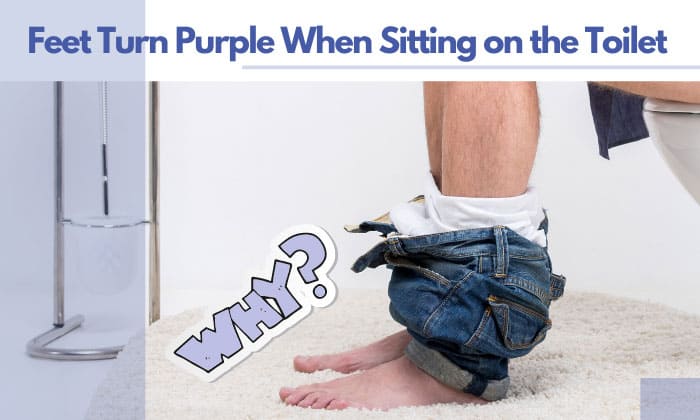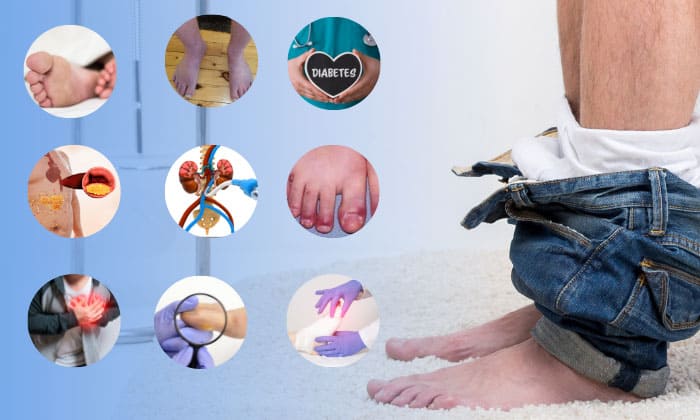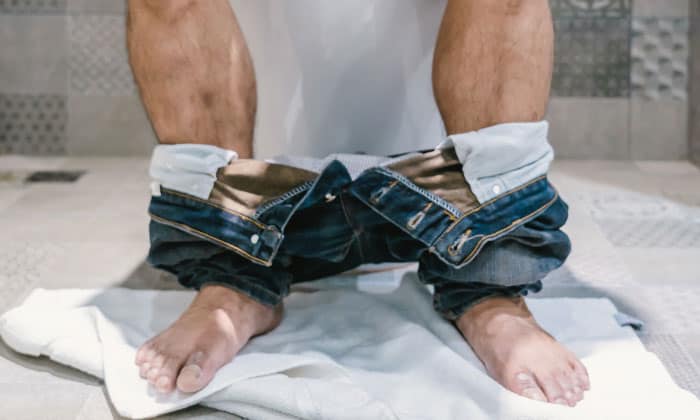One of the rarest experiences we can have is foot discoloration, which makes you wonder why feet turn purple when sitting on toilet.
While the purple spots on feet can just be bruises, purple toes can also mean poor blood circulation caused by certain health conditions we must address as soon as possible. Some examples can be:
- Acrocyanosis
- Diabetes;
- Ischemia;
- Peripheral arterial disease;
- Raynaud’s phenomenon
- Postural tachycardia syndrome (PoTS);
- Purple toe syndrome and;
- Frostbite.
Table of Contents
Why Do Feet Turn Purple When Sit on the Toilet?
This section explains why feet turn purple when sitting, especially for long periods such as staying on the toilet.
1. Bruises
Sometimes, the purple color on your feet may just be bruises you get when you bump or scrape your skin on a hard and rough surface.
It’s probably a coincidence that you noticed the color when sitting in a chair. But if you want to alleviate the purpleness, all you need to do is the following:
- Ice therapy using an ice pack, ice wrapped in a towel, or anything cold or frozen. Treat the bruise for 10 minutes and let it rest for 20 minutes before icing again.
- Heat therapy using a hot compress or warm bottle. The heat can help our bruised purple feet with blood circulation, turning the color back to normal.
- Ointment therapy with arnica, vitamin K, or vitamin C. These ingredients help with the healing process.
2. Acrocyanosis
Blue or purple feet in the elderly can be because of acrocyanosis, especially when not elevated (such as when on the toilet) or when the temperature is freezing. Most of the time, this is not harmful; all we need is elevation and warmth.
However, this can also be due to other factors such as blood or genetic disorder, vascular disease, and infection.
Treatment for acrocyanosis includes:
- Keeping the feet warm;
- Medications;
- Treating the underlying health condition that triggered acrocyanosis.
3. Diabetes
Hopefully, this is not the case for you, but purple feet and diabetes can be related. Since this health condition is commonly caused by high sugar levels that can damage arteries, which can also impede healthy blood circulation.
If you’re diabetic, ensure that you are following your doctor’s prescriptions in terms of lifestyle and other medical matters. We also recommend alerting your doctor about this situation.
If you haven’t been diagnosed as diabetic, it’s best to consult a podiatrist first.
4. Ischemia
One of the purple feet causes is ischemia. Ischemic foot is a health condition with a lack of flow of arterial blood from the heart to your feet which also results in purple toes.
This condition is caused by plaque buildup in the arteries, commonly in those with high levels of cholesterol, hypertension, and diabetes. In addition, ischemic-related health conditions are more common in adults.
Some ways that can help with the ischemic foot are:
- Being physically active such as through walking exercises;
- Wearing comfortable shoes (no tight-fitting ones) and;
- Taking prescribed medications.
5. Peripheral Arterial Disease (PAD)
This disease might be the reason for the purple on the bottom of the feet and why your legs turn purple when sitting. The culprit is the narrowing of the arteries that restrict oxygen and blood flow to the feet.
We can put PAD under medications called statins, or other prescriptions by a certified medical professional based on your diagnosis. Maintaining a healthy diet is also helpful.
If you’re sitting on your toilet bowl and you notice that your feet turned purple, it’s better to get them checked, especially if it has never happened before.
6. Raynaud’s Phenomenon
Raynaud’s is a consequence of stress, anxiety, and cold temperature. In this case, the feet may appear purple or blue when sitting or standing. Our hands can also catch this phenomenon, as well as our ears, nose, and lips.
Preventing this involves:
- Keeping ourselves warm and;
- Maintaining a healthy and balanced diet.
So don’t worry, doing your number two on a toilet doesn’t necessarily give you Raynaud’s phenomenon, but be vigilant when you get one as this can also be caused by an underlying illness.
7. Postural Tachycardia Syndrome (PoTS)
Also called postural orthostatic tachycardia syndrome, it is a condition where the heart rate abnormally increases when sitting or standing.
Individuals with PoTS can acquire dependent acrocyanosis and notice their feet turning purple when standing. You can most likely notice this while on the toilet since you will be in an upright position.
Teenagers are most prone to get PoTs, but it usually disappears when they step into their 20s. Some ways to alleviate this condition include:
- Medications;
- Picking the right exercise and;
- Drinking enough water for hydration.
We also recommend getting a check-up with a general practitioner so they can instruct you in managing PoTS or refer you to a specialist.
8. Purple Toe Syndrome
Also called trash foot or blue toe syndrome, happens when the small blood vessels in our feet are blocked, causing a lack of oxygen and blood flow to the said body part.
When you would look at pictures of purple toe syndrome, the worst-case scenarios have ulceration and gangrene since the body tissues die.
If you believe that you have this syndrome, getting treatment as early as possible will prevent it from worsening. The treatment or medical response may vary between the following:
- Anti-coagulants and antiplatelet medications;
- Stenting;
- Bypass surgery and;
- Amputation (when other treatments fail).
9. Frostbite
From the word itself, this condition depicts “freezing” because of negative or single-digit temperatures. You might not experience this while sitting on a toilet, but frostbite still causes purple feet.
Frostbite is an emergency situation and you should be taken to a hospital immediately if you experience its symptoms so the medical personnel can warm up your temperature, perform necessary tests, and prescribe you medicines if necessary.
How to Treat and Prevent Purple Feet?
The treatment and prevention of purple feet will depend on what caused it. If the purple is due to bruises, then a cold or hot compress plus ointments can help. But if it’s caused by an underlying health condition, you should address the latter to alleviate the symptoms on your feet.
We highly recommend going to a podiatrist or a general practitioner if you suddenly experience foot discoloration such as when you’re sitting on a toilet. Medical experts can diagnose your condition and provide you with proper medications if necessary.
Maintaining a healthy lifestyle and diet is also a must, and you should ask your doctor what type of exercise you can perform and what body movement to avoid.
Is It Normal to Have Purple Feet When Sitting on the Toilet?
It’s not normal that our feet would turn purple when we sit on the toilet, but it’s not always an emergency situation either.
Purple feet can happen because it’s freezing cold in your place or you have poor circulation that can be improved by working on your muscles and maintaining a healthy lifestyle. If you often ask, “Why is it that when I cross my legs, they turn purple?” it’s probably your circulation.
However, keep in mind that purple feet may also be a resonance of an underlying health condition that you may or may not be aware of, so it’s best to get diagnosed by a medical professional.
Conclusion
If our feet turn purple when sitting on toilet, it can be caused by different factors. Either you have bruises, the temperature is too cold, you have an underlying health condition, or there is a lack of proper blood flow and oxygen (circulation) in your feet.
Depending on the cause, we can address this through medications prescribed by a medical specialist or surgery, if necessary. It is, however, universally recommended that we maintain a healthy diet and lifestyle and ensure that we attend to our underlying medical needs.
Read more: Reasons why my legs fall asleep on the toilet.

I’m Paulk Webb, and I work as a writer for Saveourwaterrebates. I’m happy to put in the time and effort to conduct market research to identify the most pressing issues faced by households concerning their plumbing. Feel free to check out our guides to get the most informed recommendations for how to solve your problems.




